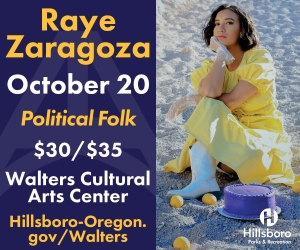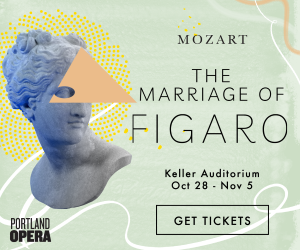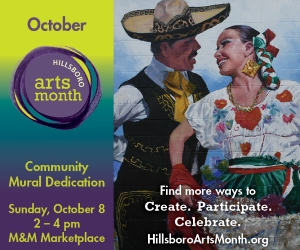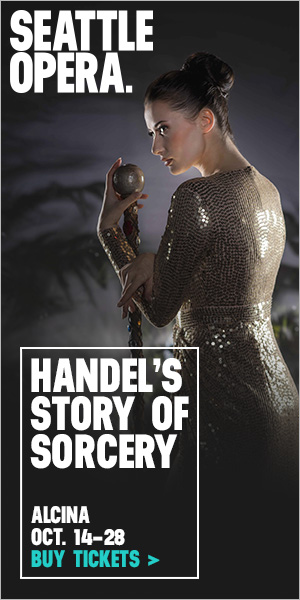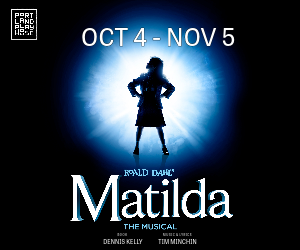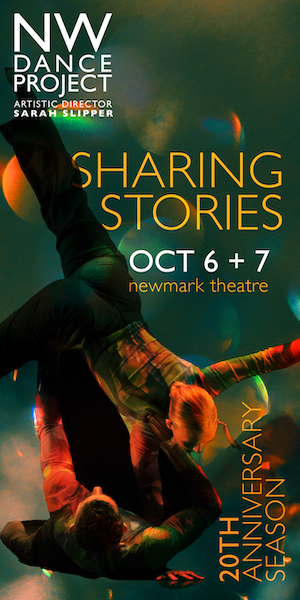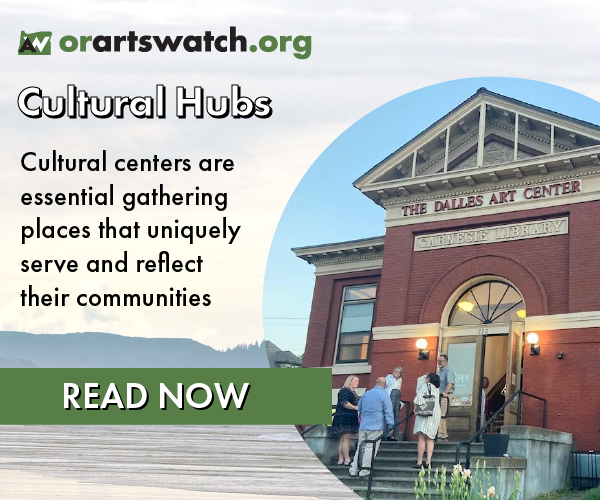
Indian culture is thousands of years old, but its art and celebrations are still new to many outside the Indian community. Sweta Ravisankar and other teachers of classical Indian dance want to change that with their exuberant, impassioned performances, such as the one her all-female dancers presented in “Chakras – The Wheel of Energy” at Hillsboro’s HART Theater on August 13.
The sold-out performance included world premieres by Ravisankar, a Portland Bharatanatyam and Nattuvangam performer, teacher, and choreographer, and by Seattle-based Bharatanatyam dance artist and Nattuvangam Manaswini Sridhar, and featured dance students from Ravisankar’s school of classical Indian dance, Sarada Kala Nilayam in Beaverton. The experience was a roller-coaster ride of energy and emotions that would build and burst at various times in a flurry of footwork and joyful expressivity.
Lovers Separated
The performance opened with “A love poem from Kurunthogai, verses from the Sangam Literature,” a 15-minute solo in the form of a varnam by Sridhar that expressed the love and separation felt between a couple living in the Kurinji Mountains during the Sangam period (roughly between the 3rd century B.C. and the 3rd century AD). It was splendidly performed by Manaswini Sridhar, a Washington State-based Bharatanatyam dancer and Nattuvangam student of Guru Hemanth Lakshman and director of her own art institution Spandana Classical Arts. She’s been studying Bharatanatyam under the guidance of Guru Suma Mani since she was eight years old, and Nattuvangam with Guru Hemanth Lakshman. She completed her Bharatanatyam Arangetram (debut performance) in 2004 and is now the director of her own school, Spandana Classical Arts. Sridhar has performed numerous times in and around Chennai, toured the USA, Europe, and Dubai, and performed in the production “Krishna” by Padmasree awardee Shobana in 2015.
A panel selected Sridhar as part of Kalpana (meaning imagination), a program in its second year (applications open in February) that Sweta created to encourage young artists of any genre by offering them a performance platform and opportunities for collaboration, if that interests them, at no cost.
Kurunthogai is a classical Tamil poetic masterpiece that is the second in a series of eight anthologies called Ettuthokai, belonging to the akam or (love) category. The poems’ flora, fauna, and landscapes are devices used to create associations with different moods, and the mountains represent the spirit of union.

A varnam is the middle dance in a Bharatanatyam concert of seven or eight dances that is the longest of them all and combines a theme with emotive storytelling and rhythmic sections. It was an interesting choice to use a varnam, which requires a considerable amount of physical endurance and mastery of the technique, as a structure to tell a love story. It’s like the choreography spoke to or was a testament to the complexity, persistence, and skill required to maintain an enduring romantic relationship.
Sridhar is a graceful and powerful dancer with notable maturity in her performance. A sense of serenity and calm radiated from her while she danced. Her emotive facial expressions, storytelling abilities, rhythmic abilities/sections, and dynamic movement around the stage, creating different shapes and patterns in space, were a testament to her ability as a seasoned Bharanatyam dancer. Watching her dance was a pleasure and added new depth to my understanding of the form.
The pre-recorded music for the performance was composed by Sridhar’s husband, Balakumar Vasudevan and Swetha Balasubramanian. Vasudevan also sang while Sridhar herself performed as the Nattuvangam. On Mridangam was Sarvesh Karthick and C. Charumathi on the Veena, and the script was by Jayasri Sridhar.
The Wheel of Energy
After an introduction by Ravisankar, the second half of the program featured an hour and fifteen-minute dance by Ravisankar for twelve dancers, titled Chakras – The Wheel of Energy, depicting the seven chakras along the spine.
I have been a fan of Ravisankar’s dancing since I saw her perform in Rasika director Jayanthi Raman’s “Anubhava” in 2015. She has a captivating smile and a dynamic range of movement that is both graceful and powerful. She is a beautiful dancer who uses her art to express emotions and her love of rhythm.
When I first met Ravisankar, she was an award-winning artist from Mumbai, India, who had just moved to Portland to pursue her Ph.D. in Cell and Developmental Biology at OHSU. She grew up under the tutelage of Guru Padmini Radhakrishnan of Mumbai, India, and later under Guru Roja Kannan of Chennai, India. She holds a master’s degree (MFA) in Bharatanatyam, one of the most ancient and sophisticated forms of Indian classical dance.
Today Ravisankar dedicates her life fully to dance, traveling back and forth between Oregon and California, teaching, and traveling the world performing. She is a true ambassador for Indian dance and culture.

According to the legendary Bharatanatyam dancer T.S.Balasaraswati, the traditional order of the Bharatnatyam (concert) — Alarippu, Jatiswaram, Shabdam, Varnam, Padam, Tillana, and Shloka or verse — “is the correct sequence for revealing the spiritual through the corporeal.”
An Alaripu is a salutation to God, the guru, and the audience. A Jatiswaram is an abstract piece that doesn’t have a mood or storyline that demonstrates forms and is purely for artistic pleasure. A Shabdam is when the Abhinaya or expressions are introduced for the first time and usually tells the story of a god from a devotee’s point of view. A Varnam is a colorful, joyous combination of storytelling, emotion, and rhythm. A Thillana is a rhythmic composition presented as a finale number fast in tempo with intricate rhythmic sequences. The Mangalam gives thanks and invokes blessings from God, the guru, and everyone present.
T.S.Balasaraswati compared the Bharatanatyam Recital to a grandly structured Temple: “We enter through the Gopuram (outer hall) of Alarippu, cross the Ardhamandapam (halfway hall) of Jatiswaram, then the Mandapam (great hall) of Shabdam and enter the holy precinct of the deity in the Varnam. In dancing to the Padams, one experiences the contentment, cool, and quiet of entering the sanctum from its external precinct. It is akin to the juncture when the cascading lights of worship are withdrawn, and the drum beats die down to the simple and solemn chanting of sacred verses in the closeness of God. Then the Tillana breaks into movement like the final burning of camphor accompanied by a measure of din and bustle.”
Ravisankar explained that each chakra is associated with different aspects of the human experience, including physical health, emotional well-being, and spiritual development. Balanced chakras lead to feelings of wholeness and well-being, while blocked chakras can cause physical, emotional, or spiritual problems.
I’m sure the explanation of each dance was helpful for some people, but as soon as the dancers got going, the information slipped away for me. Chakras was brilliantly formatted to follow the Margam or pathway of a traditional Bharatanatyam concert. Assigned to each dance was a chakra, except the fourth dance, a varnam, comprised of three chakras. In order, “Chakras” comprised two duets, two quintets, a solo, another trio, and the grand finale of 12 dancers.
The experience was a roller coaster ride of energy and emotions that would build and burst at various times in a flurry of footwork and joyful expressivity. I became completely enthralled by all of the beautiful elements on stage, from the dancer’s iridescent pink and blue silk costumes and twinkling jewelry to the rhythms of their feet, to the shapes they made with their arms, the spatial relationships between the dancers, the geometric shapes and patterns created through the choreography on the floor, and the facial expressions that were unique to each dancer, but conveyed the ecstatic experience they each seemed to be having while dancing. It was sublime, expertly crafted and performed, and deeply fulfilling to watch.
And then, when I thought I couldn’t possibly take in any more beauty, a little boy, maybe seven or eight years old, with gorgeous kohl-lined eyes, entered the stage flanked by the older dancer and danced with utmost sincerity and aplomb, completely melting my heart.
About Bharatanatyam Dance
The performance featured the two most prominent South Indian performing art forms: Bharatanatyam dance, with Carnatic music. Bharatanatyam, a dance that contains emotion, music, and rhythm, is one of India’s eight classical dance forms performed to Carnatic music.
Bharatanatyam, which translates to a dance that contains emotion, music, and rhythm, is one of India’s eight classical dance forms performed to Carnatic music. It originates in Tamil Nadu in South India, interprets Hindu mythology and spirituality, and traces its roots back to the Natya Shastra, a Sanskrit text on the performing arts written about 2,500 years ago.
Bharatanatyam is characterized by a fixed torso, outstretched angular arms, bent knees, often in a diamond position, complex rhythmic footwork, and a sophisticated vocabulary of gestures for the hands, eyes, and face. It also comes in various styles preserved in unbroken lineages by dance gurus that go back centuries. A dance student typically takes one teacher in a lifetime, mastering that style and eventually passing down what they learned to their students to preserve the specific characteristics and purity of each dance style or lineage. Classical Indian dance students don’t jump around from one teacher to another like we do here in the West. Maintaining each dance lineage’s unique characteristics and purity is essential.
About Carnatic Music
Bharatanatyam is danced to Carnatic music, which Oregon ArtsWatch music editor Matthew Neil Andrews describes as modal – five to seven notes against a drone, and it doesn’t change keys, and it almost never changes modes within a composition: “Carnatic music is largely based on actual compositions called kriti (a word that’s not unlike our words ‘opus’ and ‘opera’), of which there are thousands. Improvisation in Carnatic music tends to follow phrases from the kritis, and here it really is a bit more like improvisation on jazz standards. But again, the freedom is the freedom of creative constraints—not for nothing is Saraswati, patron goddess of music and language and education, associated with a river. A river isn’t a river without banks, beds, channels,” he notes. “Most serious western observers agree that the highly emotional quality of Indian music is a matter of intonation. It’s not the tones themselves that make the magic, it’s how you relate them—and that involves intonation, and bends, and vowel shapes, and all sorts of stuff. That thing where 3-4 notes can make you cry immediately: that’s intonation.”

In a Bharatanatyam orchestra, the Nattuvangam holds a vital role as the conductor and keeper of the beat. They play a pair of cymbals called talam, made from various metal alloys. The larger cymbal, made of iron, produces the bass sound, while the smaller one, made of brass, held in the right hand, makes the treble or higher sound. By striking the cymbals at different angles, they create sounds that mimic the dancer’s footsteps. A flat foot produces one sound while placing the heel on the floor creates another. Alternating these movements generates a pattern of hard and soft beats, resulting in a variety of rhythms. A skilled Nattuvangam accurately reproduces these patterns called jathis and verbally recites them as well. An example would be a three-beat jathis (a rhythmic pattern of syllables), which sounds like “Ta Ki Ta,” or a four-beat jathis, “Ta Ka Dhi Mi.” If you want to see this in action, you can check out Ravisankar on Instagram, where she demonstrates the recitation, plays the cymbals, and dances out the rhythms.
Student Professionals
Ravisankar operates two Bharatanatyam schools, one in Oregon and one in the San Francisco Bay Area. The performance of “Chakras” consisted of students from both schools.
Indian dance students take only one teacher in a lifetime. Everybody is a student forever, no matter what level they are, and will always be associated with that school, even though some of the dancers may go off and perform as soloists outside of the school. As a result, in Indian dance, being a student doesn’t necessarily mean that they aren’t a professional. Most of the dancers on that stage have performed an arangetrum, or a solo graduation performance of all the dances In a Bharatanatyam repertoire, consecutively in one evening. They have performed extensively as soloists and have most likely been in many more cumulative performances than many professional Western dancers and so, while called students by Indian protocols, they would be considered professionals by Western standards.
Final thoughts
Incredibly, the performance was accompanied by an all-female live orchestra, with music composed by Harini Acharya, a Portland-based musician. With Sridharini Sridharan on Nattuvangam (cymbals), who is also a Bharatanatyam dancer with her own school; Laya Kashyap on mridangam (drum); Harini Ganesh on violin; and vocals by Acharya.
The first three or four opening notes on the violin evoked such deep emotion and immediately brought tears to my eyes. It was also profoundly moving and inspiring to see a stage full of women artists only. The future is female, as they say.
***
Oregon ArtsWatch Senior Editor Brett Campbell contributed to this report.









